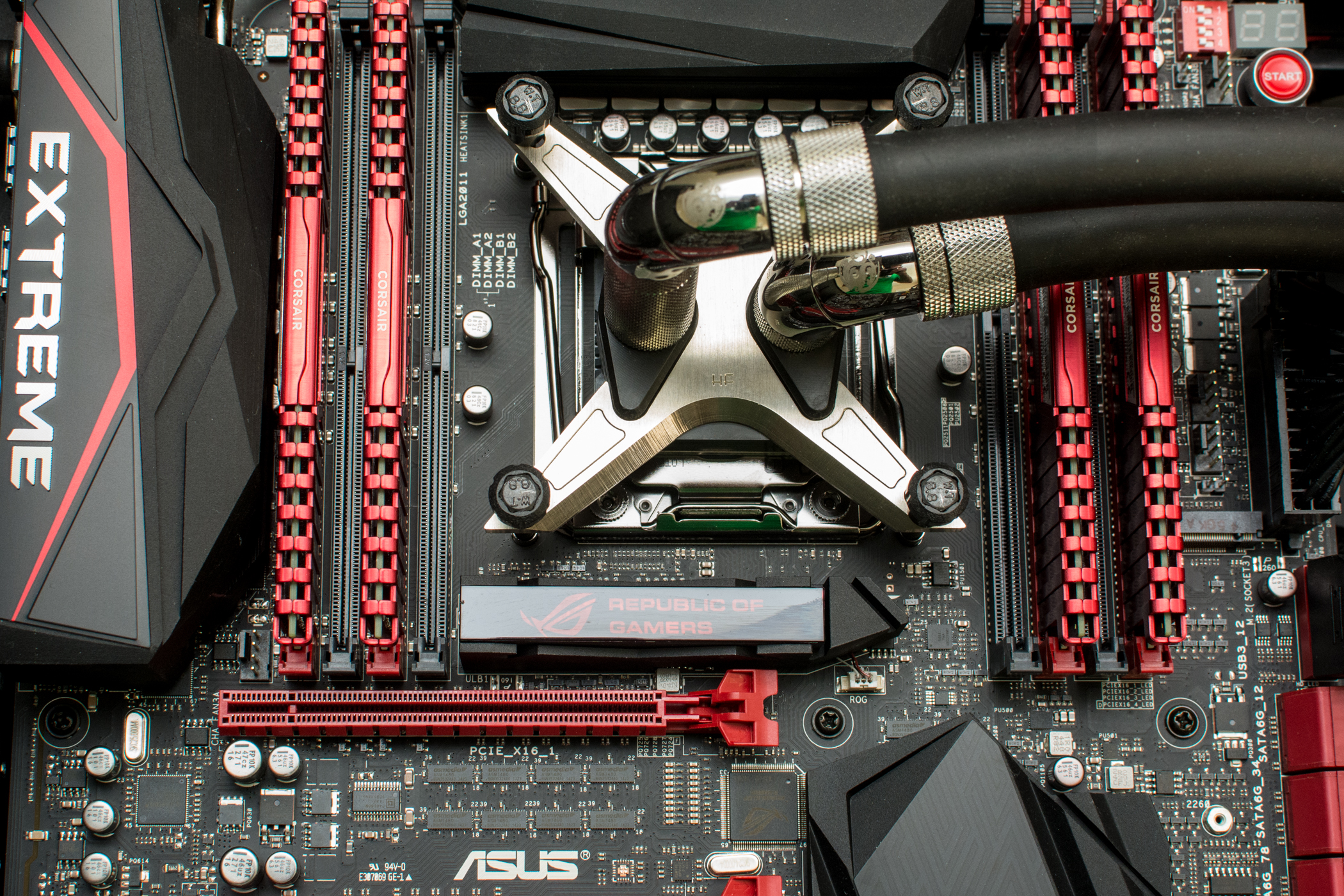Let’s start off with a couple of quick benchmarks to show the improvement of X99 from X79:
SuperPi 32M – Single Threaded
This shows the improvement of single threaded performance and DDR4 on X99 – regardless of how many cores you have for an equivalent clock speed anything will be faster for X99.
Cinebench r15 – Multi Threaded
So here we can see the IPC improvements in the CPU coupled with DDR4 have helped to give a small lead to X99. The 5960X of course would do even better here with it’s additional two cores. Now let’s focus purely on the DDR4 memory speed:
AIDA 64
Here we are testing DDR4 memory bandwidth with the Corsair Vengeance LPX’s secondary XMP profile at 3000 CL16:
If we compare to a similarly priced Corsair memory kit on X79 (2133 CL9) we can see that X99 improves on every single metric except L3 cache latency:
So in conclusion even for someone coming from X79 there are significant improvements to be had even ignoring any additional cores you may decide to also go for! Bear in mind though that these benefits will mainly affect processing power – so those of you building for a workstation, or a photo/video editing rig will see good improvements, but for many mainstream gaming scenarios we are not cpu limited. Very few games still take advantage of more than 4 cores. High cpu and clock speed will only really affect frame rates when playing poorly optimized console ports or when trying to hit the very high minimum frame rates for lightboost. In general Z97 is a better buy for most gamers running 1-2 GPUs simply because it is cheaper. For a budget setup that means more money to spend on GPUs. For those gamers with deeper pockets X99 however gives more PCI lanes for running 3-4 GPUs.
At this point we could launch a ton more benchmarks showing how X99 is faster all around than X79, but this is not a CPU review and we already know these answers. Instead let’s focus on the motherboard and look at the thermals on the board too under load – of critical interest here is the VRM temps – highest recorded under load was 81C – very respectable – it’s worth noting that HWiNFO does track the VRM temps reported by AI Suite:
 We also did a manual check of the motherboard under ~250W of load and the hottest part measured was the VRM heatsink at 56C. The heatpipe also did a good job of transferring VRM heat to the secondary heatsink over the IO cover. This secondary heatsink was 46C. We did not notice any thermal throttling due to VRM temperatures that we did see on the Rampage IV. The PCH stayed very cool which was not a surprise, it only really gets hot when covered with multiple air cooled GPUs.
We also did a manual check of the motherboard under ~250W of load and the hottest part measured was the VRM heatsink at 56C. The heatpipe also did a good job of transferring VRM heat to the secondary heatsink over the IO cover. This secondary heatsink was 46C. We did not notice any thermal throttling due to VRM temperatures that we did see on the Rampage IV. The PCH stayed very cool which was not a surprise, it only really gets hot when covered with multiple air cooled GPUs.
Lastly let’s take a look at voltages under load with the default “auto” LLC as measured by the OC Panel and a DMM measuring at the provided sense points on the motherboard:
VCCIN –
Set to: 1.92V
Measured by OC Panel: (Idle) 1.925V -> (Load) 1.95V
Measured by DMM: (Idle) 1.951V -> (Load) 2.02V
VCore –
Set: 1.40V
Measured by OC Panel: (Idle) 1.400V -> (Load) 1.400V
Measure by DMM (Idle): 1.411V -> (Load) 1.422V
VDRAM –
Set: 1.38
Measured by OC Panel: (Idle) 1.375V -> (Load) 1.375V
Measured by DMM: (Idle) 1.400V -> (Load) 1.406V
VCache –
Set 1.4V
Measured by HWiNFO: (Idle) 1.388V -> (Load) 1.406V
Measured by DMM: (Idle) 1.410V -> (Load) 1.426V
VCCSA –
Set 1.04V
Measured by HWiNFO: (Idle) 1.072V -> (Load) 1.056V
Measured by DMM: (Idle) 1.055V (jittery) -> (Load): 1.060V
It’s also worth noting that there was a 12-13mV ground shift between the motherboard ground sense point and the OC Panel ground point.
Ignoring the absolutes it is clear that there is a big shift due to LLC on VCCIN that was not reported as large by the OC Panel. This is also true for VCore where the OC Panel reports the voltage as flat. This could be a problem with the voltage sense circuitry accuracy, however it’s more likely a difference in where the voltage is sensed. I suspect that the sense points used by the OC panel and all internal circuitry are where they should be and that Asus instead needs to improve the location of where the DMM probe points actually tap on the motherboard.
Fan Control
By setting the fan profile to PWM we had great control of fan speed. The CPU fan header is rated for 1A according to the manual. We didn’t test this high, but we did plug 4 PWM EK Vardar 1850RPM fans in which are rated at 0.12A (0.48A total). At minimum PWM setting in the BIOS (20) the Fans spun at 700RPM, and at max they hit about 1715RPM. Initially we suspected this was due to the high current draw but the 12V line had not drooped and was a steady 12.1V. Dropping the total number of fans to 1 increased the maximum fan speed to ~1770RPM and the minimum to 800RPM. This indicates that the PWM drive circuitry is not handling the load of these particular fans very well.
When running in voltage control mode the voltage and fan speeds remained the same but the lowest the fans could now spin was 900RPM for the group of five and 830RPM for the individual fan.
If this is compared to a high end fan controller like an Aquaero 6 then the high end speed for a single fan remains the same, but once four fans are running the top end speed drops to 1624RPM due to voltage droop. This is no match for Asus which can deliver the power the Aquaero can’t – this is surprising given that the Aquaero claims to output several amps a channel. On the low end however the Aquaero can take the fans all the way down to 275RPM in PWM or even lower in DC voltage mode.
So the Asus built in fan controllers then do very well in comparison to the Aquaero – the only weakness is the PWM drive strength when daisy chaining multiple fans and the artificial limits Asus have imposed on the minimum RPMs. It would be nice to see Asus work on this lower limit, as 800RPM is still quite high for a “silent” system.


















The Ultra has not dissapeared, see Asus Z10 D8 WS + E5-2699v3, it’s called Workstation.
Agreed, I was referring to systems that could overclock While “real” workstation users will use that workstation board happily my “idea” of ultra enthusiasts consist of people who won’t give up their overclocked performance but still want more cores and are willing to pay for 2P. Those same workstation users who prefer more cores might even be happy with a 4P after all. Since the SR2 there have been no real overclockable 2P chips.
While “real” workstation users will use that workstation board happily my “idea” of ultra enthusiasts consist of people who won’t give up their overclocked performance but still want more cores and are willing to pay for 2P. Those same workstation users who prefer more cores might even be happy with a 4P after all. Since the SR2 there have been no real overclockable 2P chips.
[…] Asus Republic of Gamers Rampage V Extreme X99 Motherboard Review for Overclockers! […]
Nice Review! Helped me a lot!
Can you tell me the name of the Waterblock in the top picture please? It looks so sick!
MIPS IceForce HF – MIPS closed down and I think AquaTuning bought all the remaining stock – so that might be your best for these if any remain!
Thank you very much!
[…] Asus Republic of Gamers Rampage V Extreme X99 Motherboard Review for Overclockers! […]
I think this board is too much oriented to the LN2 and TEC peoples. Of course we live under their umbrella so if ASUS covers those peoples, we are covered too. But sadly, most of us mortals won’t even use these hardware level (and few software level) features for WC builds, so don’t you think there should be lower-dog of ROG (probably R5 Formula) for X99? Or does Deluxe suffices?
I have to admit I’d rather see a Gene matx version before a formula. Yes for some the deluxe suffices for that role though
[…] Asus Republic of Gamers Rampage V Extreme X99 Motherboard Review for Overclockers! […]
Comments are closed.